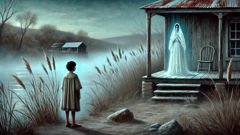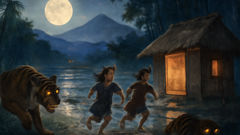Introduction
When the sun sets behind the rolling hills of the borderlands and shadows stretch long over the winding Rio Grande, an uneasy hush settles along the water’s edge. Here, in the shimmering twilight where Mexico and the United States touch, the landscape holds stories older than any map, whispered through the mesquite and carried on the sighing wind. But none chills the blood quite like the legend of La Llorona—the Weeping Woman—whose mournful wails drift through the night, echoing between river and sky, and weaving themselves into the dreams of all who call this place home.
The Rio Grande’s banks are alive with contrasts: bustling border towns where life bursts with color and music, and lonely stretches where the current glides silently past gnarled cottonwoods and the ruins of long-forgotten ranchos. Children play in the dust by day, their laughter mingling with the calls of grackles and the clatter of distant freight trains. By night, doors are drawn shut and families gather close, their faces flickering in the blue glow of television screens or the warm light of candles. Always, there’s a sense that something unseen lingers beyond the fence lines and the muddy water—a presence that belongs not to this world, but to another, one built on heartbreak, mystery, and the kind of fear that seeps into your bones and refuses to let go.
To locals, La Llorona is more than a ghost story told to keep children from wandering too near the river. She’s a warning, a memory, a symbol of sorrow too deep to name. Some say she was once a beautiful woman named María, proud and poor, who fell in love with a man beyond her station. Others claim she’s as old as the river itself, her origins lost to time and tragedy. All agree on the heart of her tale: a mother’s unbearable loss, a moment of madness beneath the moon, and a curse that binds her forever to the restless water. Her cries—"¡Ay, mis hijos!"—carry across the fields and barrios, piercing the stillness with a grief that never fades.
Tonight, as dusk yields to night and silver clouds drift over the Rio Grande, the legend stirs once more. The air is thick with the scent of mesquite smoke and wildflowers, and somewhere near the river’s bend, a faint, keening wail rises above the chorus of cicadas. It’s a sound that has haunted families for generations—a summons to remember, to fear, and to wonder what truths might lie hidden beneath the surface of the moonlit water.
I. Moonlit Echoes: The First Sighting
On the outskirts of Ciudad Juárez, where the city’s neon lights flicker across the river and the scent of grilled elote hangs in the humid air, families have always treated the Rio Grande with respect—and a measure of dread. Even the bravest children kept their distance after sunset, warned by abuelas whose own mothers had whispered warnings of La Llorona as they tucked them in for the night. It was said she appeared when the moon was high, her cries rising with the mist off the water, her presence a curse and a warning.

Diego Martínez was twelve the first time he heard her. His family lived in a small cinderblock house pressed close to the border fence, its windows rattling with every gust of desert wind. That August night, heat pressed down like a heavy blanket, and Diego found himself unable to sleep. Restless, he slipped out onto the back stoop, drawn by the music of crickets and the gentle swish of the river beyond.
The world outside shimmered under the moon’s pale eye. Across the water, he could see the faint outlines of El Paso’s buildings, their lights dancing in the heat haze. But Diego’s attention was drawn to the reeds along the riverbank, where a strange chill seemed to rise from the earth itself. The air grew still, and even the insects fell silent. That’s when he heard it: a low, keening wail, so full of sorrow it made his skin prickle. The sound rose and fell, drifting over the water, threading through the night.
He squinted into the darkness and saw her. She was tall and impossibly thin, her hair as black as the river’s depths, her dress torn and stained by mud. Her face was hidden, but her hands—so pale they almost glowed—clutched at her chest as she sobbed. "¡Ay, mis hijos!" The words clawed at the air. Diego watched, paralyzed by fear, as the figure wandered along the bank, sometimes vanishing into mist, sometimes flickering back into view like a trick of the moonlight.
He stumbled back inside, heart hammering in his chest. For weeks afterward, Diego hardly slept. His grandmother, sensing his fear, pressed a rosary into his palm and whispered prayers against the darkness. But Diego had seen what he’d seen. Every night, he listened for her. Sometimes, he heard nothing. Sometimes, the wind seemed to carry a single, distant sob, and he’d pull the covers tighter around his shoulders, wishing the legend were just a story after all.
As Diego grew older, he realized he was far from alone. Nearly everyone in the neighborhood had a tale—an uncle who’d glimpsed a woman’s silhouette gliding through fog, a cousin who’d found footprints in the mud that vanished without a trace. The stories changed with each telling, but the fear remained constant. Some claimed La Llorona lured children to their doom; others believed she appeared to those who’d lost someone, her grief a mirror for their own. In every version, she was inescapable—a part of the river, as enduring as its current.
II. The Woman in White: Roots of a Borderland Legend
As years passed, stories of La Llorona became woven into the fabric of border life. Her legend stretched back centuries, yet along the Rio Grande, it took on its own shape—colored by the pain and resilience of those who called the borderlands home.

They said that long ago, before fences cut the land and divided families, a woman named María lived in a village by the river. She was renowned for her beauty—skin radiant as morning light, eyes dark as obsidian. She caught the eye of a wealthy rancher from across the river, and their love blossomed in secret, crossing boundaries of class and culture. When he left her for another, wealthier woman, María was left with two children and a heart shattered by betrayal.
On a night thick with sorrow, María wandered with her children along the riverbank. No one knows what madness took hold—some whisper it was grief, others say it was the river itself calling out for sacrifice. In a moment of anguish, María lost herself, and her children vanished into the current. When she realized what she’d done, her screams pierced the night, echoing across water and stone. Her body was found days later, but her spirit lingered, trapped by guilt and longing.
From that day, her ghost wandered the river’s edge, searching for her lost children. She became La Llorona—the Weeping Woman. To some, she was a vengeful spirit who took wandering souls. To others, she was a mother so broken by loss that even death couldn’t end her suffering.
In the border towns that grew along the Rio Grande, the story changed with each generation. During times of hardship—when drought dried up crops or violence swept through neighborhoods—La Llorona’s cries were heard more often. Her legend became a vessel for collective sorrow: a way for people to speak of loss too great to bear, to explain the unexplainable disappearances and tragedies that haunted their lives.
Abuelas taught children not to stray too close to the water at dusk. Parents lit candles on All Souls’ Day, praying that the souls of the lost would find peace. Some believed that if you heard La Llorona’s wail close by, you were safe—but if her cries sounded distant, she was right behind you, reaching out with icy hands.
On moonless nights, when the wind howled and dogs barked at shadows, families huddled together, comforted by the warmth of shared stories. They knew that La Llorona belonged to them—not just as a cautionary tale, but as a symbol of endurance, a reminder that sorrow could be survived, even if never forgotten.
III. Border Spirits: Encounters Through Generations
In every generation, La Llorona found new witnesses. Her legend adapted to shifting landscapes and languages, crossing fences and bridges, flowing through time like the river itself. Her voice was woven into lullabies and warnings alike, a ghostly refrain haunting the dreams of children and adults.

One autumn, Rosa Delgado—Diego’s niece—walked home from her after-school job at a bakery in Sunland Park. The air was crisp and full of the scent of roasting chiles. She usually took the bus but that night, emboldened by a recent birthday and eager to prove her independence, she cut across the old levee road, walking close to the river as dusk fell.
As she hurried along, Rosa felt a sudden chill, as though invisible eyes watched from behind mesquite branches. The wind shifted, bringing with it a sound both familiar and impossibly sad—a woman’s wail, high and broken. Rosa stopped, her heart thudding in her chest. She scanned the shadows along the bank. There, half-hidden among tangled reeds, she glimpsed a woman in white, her hair wild and eyes shining with tears. Rosa froze, caught between fear and curiosity. The figure drifted toward her, arms reaching out—not in menace, but in longing. Just as Rosa opened her mouth to call out, a gust of wind scattered the vision. The river lay empty once more.
Rosa ran all the way home, breathless and trembling. She told her mother, who crossed herself and pressed her close. That night, as Rosa lay awake, she realized something new: the sadness in La Llorona’s eyes matched the sorrow she’d seen in her own mother when news came that a cousin had gone missing while trying to cross the border. The legend, she understood then, was more than a warning—it was a reflection of the grief that flowed through their family, their community, their entire world.
In the years that followed, more stories emerged. Migrants moving through the night sometimes spoke of seeing a woman in white guiding them away from danger, her voice urging them to avoid deep water or hidden patrols. Others told of hearing cries that led them back to safety when they were lost. For some, La Llorona became a guardian spirit as much as a harbinger of doom—a reminder that even in despair, there could be mercy.
The legend grew with every retelling, shaped by the tragedies and triumphs of border life. In times of joy, she faded into the background; in times of loss, her voice rose again, uniting generations with a sorrow that was both personal and universal.
Conclusion
La Llorona’s legend endures because it is rooted in the landscape and soul of the borderlands. She is more than a ghostly warning—she is a mirror for grief and resilience, a voice for those who have lost and for those who wait by the water’s edge. In every wail, there is history; in every shadow, a story. The Rio Grande continues its journey, bearing witness to sorrow and hope alike.
Even now, when the river glimmers under a full moon and cicadas sing in the grass, people pause to listen. Some hear only wind and water. Others, with hearts attuned to sorrow, catch the faintest echo of La Llorona’s cry—an eternal lament woven through generations. Her story remains as much a part of border life as the river itself: enduring, mysterious, and forever flowing.













